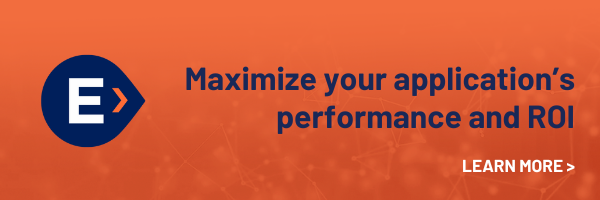February 14
With ever-evolving technology, there are always new opportunities to improve your organization’s data strategy. Whether it’s a new way to run an application or a new strategy framework, these changes can benefit entire industries to create impactful, lasting change.
Below, we’re going to discuss future-proofing your data strategy by blending cloud and edge computing.
The Differences Between Edge Computing and Cloud Computing
Edge and cloud computing are two different architectures that organizations can use to run applications. Here are the differences between the two:
Cloud Computing
Simply, cloud computing is the process of running applications in the cloud. There are multiple types of cloud computing, including:
- Private cloud.
- Public cloud.
- Hybrid cloud.
- Multi-cloud.
Use Cases
Since the cloud can be used in many ways, there are a number of use cases for cloud computing.
- Organizations with large amounts of data. With the cloud, even enterprise organizations can access, evaluate, and utilize their data to make smarter business decisions.
- Teams looking to efficiently collaborate. With remote working on the rise, it’s more important than ever to seamlessly connect with your team members, even if you’re on opposite sides of the globe. Many organizations rely on the speed of the cloud to give their employees the information and connection needed to stay productive.
- Web servers. As web servers often need to scale, the cloud provides flexibility and quick response times for end users.
These, of course, are just a few of the use cases. Countless organizations utilize cloud computing for these benefits and more. In fact, by 2024, it’s estimated that “enterprise cloud spending will make up 14% of IT revenue globally.”
Benefits
Organizations utilize cloud computing for several reasons, including the benefits that this environment can provide.
- Adaptability. Application needs change frequently as the application evolves. When that happens in a cloud environment, it’s often possible to scale your usage as needed.
- Security. Many organizations know that their data is secure within a cloud environment. In addition, new technology allows cloud providers to keep an overview of the system.
- Speed. With speed and agility that many remote organizations need, the cloud has the ability to power certain applications to their best performance. This allows your team to quickly connect with the people and information that they need.
- Disaster recovery. With certain cloud strategies, disaster recovery can be done by backing data up to the public cloud. Some organizations may even use more than one public cloud to ensure business isn’t interrupted in the case of an outage.
- Storage. Many organizations utilize the cloud for data storage, as it’s a cost-effective way to store and access information as necessary.
Edge Computing
Edge computing architecture shifts key processing tasks away from a centralized location and pushes them to servers and devices on the outer “edges” of the network. These edges are where the actual computing takes place.
Use Cases
Use cases for edge computing are typically fast-paced, always-on applications, including:
- Mobile applications. Mobile applications must have low latency in order to efficiently operate and provide a positive experience for the end user.
- 5G (and beyond). As STL Advisory explains, edge computing is a key to operational 5G. In addition, as 5G matures and we make our way into 6G, it will be crucial to keep the data processing as close as possible to end users.
- Internet of Things (IoT). Whether it’s through autonomous vehicles, smart watches, or thermostats, the IoT connects us in endless ways. With so many people heavily relying on these devices, it’s important that they are connected to the most efficient architectures.
Benefits
For the right applications, edge computing has a number of advantages, including:
- Speed. Edge computing is able to deliver fast response times due to locating key processing functions closer to end users significantly reduces latency.
- Bandwidth. With more data on the network edge, the overall volume of traffic flowing to and from central servers is reduced, freeing up bandwidth throughout the entire system.
- Reliability. Edge computing architecture distributes processing tasks throughout the network, which tends to make it more resilient than centralized systems.
- Cost. With applications running more effectively on the edge, it’s no surprise that industry leaders saw a cut in costs. In fact, Interknowlogy shared that “enterprises across industries can expect a 10 to 30% reduction in costs from using edge computing and an average operational cost savings of 10 to 20%.”
Key Differences
The key difference between edge and cloud computing is the location where the data processing takes place.
Cloud computing is best for scalable applications that need to be ramped up or wound down according to demand. Web servers, for example, can request extra resources during periods of high server load, ensuring seamless service without incurring any permanent hardware costs.
Edge computing is suitable for real-time applications that generate a large amount of data. For example, it benefits the Internet-of-Things (IoT), which manages smart devices that are each connected to a local network.
Combining the Strengths of the Cloud and Edge Computing
Many feel obligated to choose either cloud or edge computing, but the best results are often found at the intersection of both.
Enhanced Capabilities
By simultaneously utilizing cloud and edge computing, your organization can reap the rewards of both. For example, you can create a strategy that includes colocation, which ensures the computing takes place close to the end-user, creating a seamless experience — even for your most demanding workloads.
Some of these benefits of a combination strategy include:
- Higher reliability. By combining the reliability of edge computing with the disaster recovery benefits of the cloud, your organization will feel confident that your system can stay afloat. Even if the core servers are forced to go offline briefly, many essential services can still be delivered on the edge thanks to a combination of local processing and regional edge data centers.
- Overall business improvements. For example, Evoque’s 10-region structure for data centers helps improve latency and allows us to provide you with high-speed access to your data through 99.999% availability, which improves the experience for your team and end users.
- Reduced latency. For industries where milliseconds are valuable, utilization of both the cloud and edge computing can free up your bandwidth, lower your latency, and improve the performance of your applications.
What Industries Are Benefiting?
For businesses that can be disrupted by even a second of downtime, the benefits of a cloud and edge computing strategy can make all the difference. That’s why many industries are implementing this combination of architecture, including:
- Augmented and virtual reality.
- Healthcare.
- Other autonomous industries, such as engineering.
- Smart transportation, such as self-driving vehicles.
- Supply chain and supply chain management.
While this list is in no way exhaustive, these industries have leading organizations that are seeing drastic benefits from creating a data strategy that utilizes both cloud and edge computing.
Why a Flexible Approach Is Necessary for Long-Term Scalability
By adopting new architectures, like edge computing, to your organization’s data strategy, you’re helping implement the best possible environment. However, these ideal environments frequently change, which makes flexibility crucial for your data strategy.
With Multi-Generational Infrastructure (MGI), your organization’s data strategy is built to optimize your current workload deployments while having flexibility for the future. To make sure you get the most out of your data strategy, partnering with cloud consultants who can help you create, implement, and optimize your plan is key for ongoing success.
Contact us today to speak with our experienced cloud consultants who can help you create the best data strategy for your organization.




